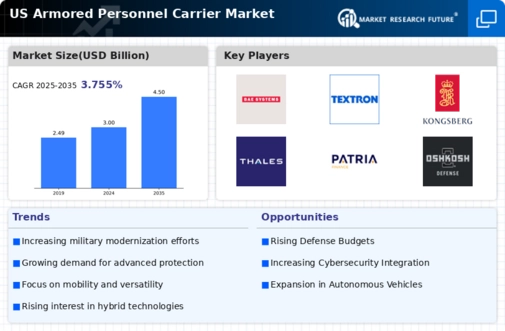The US Armored Personnel Carrier Market is characterized by a highly competitive landscape driven by advancements in technology, evolving defense strategies, and increasing government expenditure on military modernization. As nations strive to enhance the capabilities of their armed forces, armored personnel carriers play a critical role in ensuring troop safety and operational efficiency in combat scenarios. Various manufacturers with diverse portfolios are actively competing to meet the dynamic requirements of military forces, ensuring they stay ahead in innovation, production capacity, and responsiveness to emerging threats.
This sector is influenced by factors such as geopolitical tensions, technological advancements, and a focus on providing superior performance, protection, and versatility in field operations.General Dynamics has established itself as a formidable player in the US Armored Personnel Carrier Market, recognized for its robust product offerings and sustained market presence. Its strengths lie in its innovative engineering capabilities and commitment to advanced vehicle technology, ensuring reliability and effectiveness in various mission profiles. The company has achieved significant milestones by developing a range of next-generation armored vehicles tailored to meet the demands of the modern battlefield.
General Dynamics focuses on enhancing the survivability and lethality of its armored personnel carriers while maintaining a flexible approach to design and integration, thereby securing a competitive edge in the market. With a strong reputation for quality and performance, General Dynamics continues to build on its extensive experience in defense solutions, reinforcing its position as a trusted partner for the US military.BAE Systems holds a significant position in the US Armored Personnel Carrier Market, offering a suite of products and services designed to meet the diverse needs of military operations.
Known for its armored vehicles, BAE Systems provides cutting-edge solutions that emphasize protection, mobility, and technological integration. The company's market presence is marked by its strategic mergers and acquisitions, which have expanded its capabilities in vehicle design and production. Key products include advanced armored personnel carriers that are engineered to withstand modern threats while ensuring troop safety and readiness. BAE Systems leverages its robust research and development capabilities to continuously innovate, fostering a culture of excellence in defense technology.
The company’s focus on collaboration and partnership with various military branches highlights its strengths in delivering tailored solutions, providing technicians and engineers who work directly with the US armed forces to understand their requirements and enhance operational outcomes.




















Leave a Comment